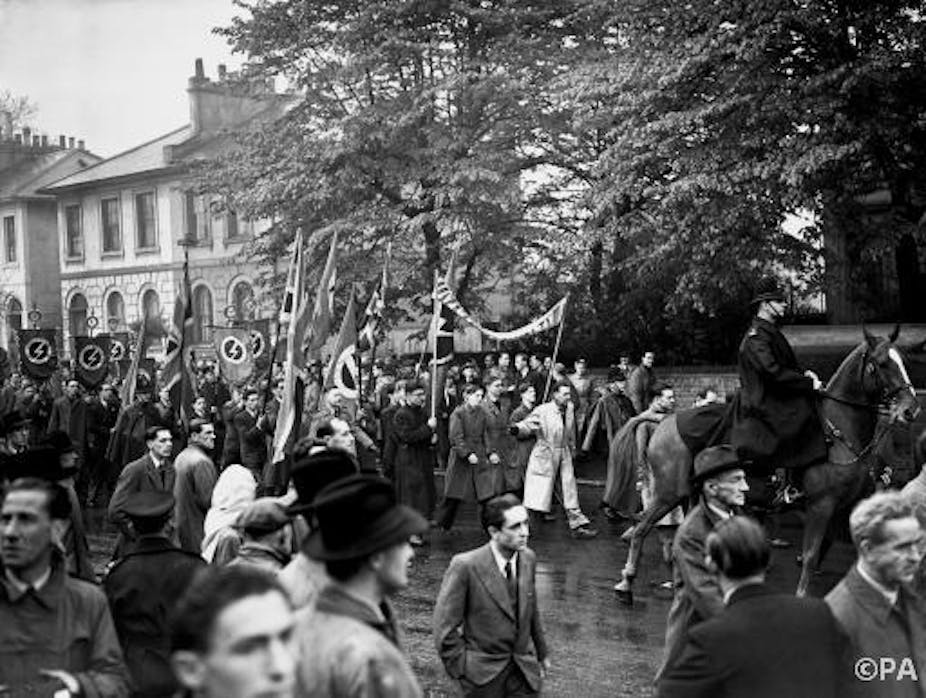The fear of a federal Europe has eurosceptics riled once again. David Cameron is increasingly dialling up his rhetoric in response to Jean-Claude Juncker’s candidacy for head of the European Commission, with Juncker’s reported advocacy for a “United States of Europe” driving right-wing euroscepticism to a new pitch – unsurprising after a European parliament election that saw a broad surge in anti-EU voting.
The eurosceptic advance in the elections led to much comment about the apparent linkage between the “far right” and anti-Europeanism. Many commentators continue to run with the assumption that opposition to the European project is a given for the far right, and that the two are synonymous.
This is questionable in the context of today’s politics, but historically it’s downright incorrect. The far right in Europe has often been enthusiastically pan-European.
In the aftermath of the 2014 elections, it is clear that an anti-EU stance is not exclusively a marker of the far right. The successes of the Coalition of the Radical Left (SYRIZA) in Greece and the Five Star Movement in Italy show that opposition to the EU can be found across the political spectrum. But just as euroscepticism is not tied to one political tendency, nor is europhilia – and if we take an historical look at the far right, we find a long history of pan-Europeanism.
Federate or be destroyed
World War I not only saw the end of three multi-ethnic Empires in Europe, but ushered in successor nation states and the new force of Bolshevism. The devastated “mighty continent” was faced with the global challenge of the USA, the only combatant nation to emerge enriched from the conflict.
For some ideologues on the far right, these changes meant that Europe had to abandon nationalism. One such thinker was the Great War veteran, novelist and political activist Pierre Drieu la Rochelle. In a series of books and articles, Drieu la Rochelle argued that Europe faced a stark choice. Writing in 1922, he argued that “if Europe does not federate she will destroy herself or be destroyed by others”.
He expanded on this federalist dream in Genève ou Moscou (1928), L’Europe Contre les Patries (1931), and in his collection of essays Socialisme Fasciste (1934). It was his belief in a European state that led him to active collaboration with the Nazi occupation of France – and his dismay at the failure of his European idea was expressed in his novel L’homme à Cheval (1943). After Liberation in 1944, Drieu went into hiding in Paris, then committed suicide – and in doing so, created a potent myth of martyrdom for the post-war far right.
New Europe, New Order
If Drieu la Rochelle’s belief in a European project underpinned his collaborationism, then he was far from being alone. Once Nazi Germany attacked its erstwhile ally, the Soviet Union, a new propaganda opportunity opened for the Nazi regime. Now German expansionism was no longer presented as the triumph of the Nazi state, but as a European crusade against Bolshevism. In response to that idea, volunteers poured into the recruiting stations, not only in countries occupied by Germany, but also in those that were not, such as Spain and Vichy France.
There was a high degree of Nazi cynicism in play here – but as the war turned against the Nazis, so the European idea gained greater traction. In particular, the SS made it a core plank of the recruitment and indoctrination of volunteers for the Waffen SS. By 1944, more than half of the 900,000 men in the Waffen SS were non-Germans, motivated by an ideological mix of anti-Communism, anti-Semitism and pan-Europeanism and fighting under slogans proclaiming a “New Europe” and a “New Order”.
It wasn’t just the Nazis who pushed the idea of a united Europe. After the collapse of Mussolini’s government in Rome, and the dictator’s temporary imprisonment, the Fascists set up a new government and party based at Salo. The Fascist Republican Party held its first congress in November, 1943, and agreed a new manifesto – point eight of the Fascist Manifesto argued for “the realisation of a European community, with a federation of all nations” which accepted Fascist principles. Interestingly, the UK was specifically ruled out of this Fascist utopia due to its “euroscepticism”!
Nation Europa
In the UK, Britain’s leading pre-war fascist, Sir Oswald Mosley, returned to politics in the post-war period with his conception of “European socialism”, fighting under the slogan of “Europe a Nation”.
Mosley’s The Alternative (1947) was influenced by pan-European ideas, and he went on to claim that as he had abandoned nationalism, so he had abandoned fascism. The concept of a united Europe found a strong purchase among the post-war far right, as it sought to rescue its politics from the ruins of total war and genocide and find an answer to Europe’s weakness in the face of Soviet and American power.
For many on the far right, the idea of “Nation Europa” seemed to offer new possibility for their politics, and it transformed their vision of how the continent should look.
The strong, continuous tradition of pan-Europeanism on the far right is undeniable. Just as the anti-EU tendency is not confined to parties on the political right, neither is support for a European “project” confined to the centrist mainstream.

